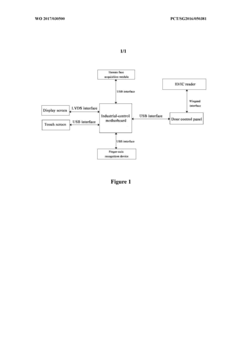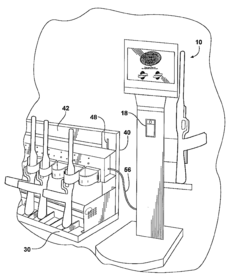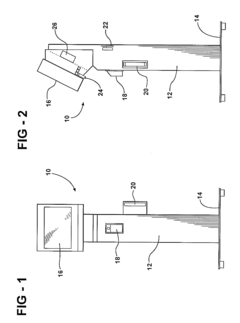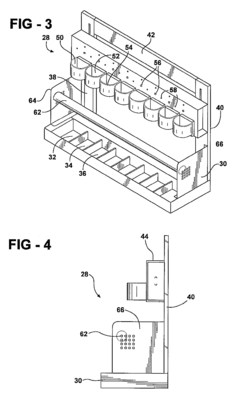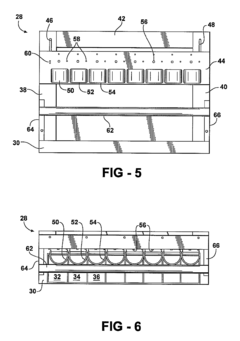How Throttle Body Technology Supports Biometric Access Control
JUL 18, 20259 MIN READ
Generate Your Research Report Instantly with AI Agent
Patsnap Eureka helps you evaluate technical feasibility & market potential.
Throttle Body Biometrics: Background and Objectives
Throttle body technology, traditionally associated with automotive engine control, has recently emerged as a promising solution in the field of biometric access control. This innovative application represents a convergence of mechanical engineering and advanced security systems, offering a unique approach to identity verification and access management.
The evolution of throttle body technology dates back to the early days of fuel injection systems in automobiles. Initially designed to regulate airflow into the engine, throttle bodies have undergone significant advancements over the years, incorporating electronic controls and precision sensors. This progression has laid the foundation for its adaptation to biometric access control systems.
In the context of biometric access, throttle body technology leverages its core principles of precise flow control and sensor integration to create a novel method of identity verification. The primary objective of this technological fusion is to enhance security measures while maintaining efficiency and user convenience in access control scenarios.
The integration of throttle body principles into biometric systems aims to address several key challenges in traditional access control methods. These include improving accuracy in identity verification, reducing false positives and negatives, and enhancing the overall robustness of security systems. By utilizing the precise control mechanisms inherent in throttle body design, biometric systems can potentially achieve more nuanced and reliable readings of physiological characteristics.
Furthermore, this technological convergence seeks to expand the scope of biometric identifiers beyond conventional methods such as fingerprints or facial recognition. The adaptability of throttle body technology allows for the exploration of novel biometric markers, potentially including subtle variations in breath patterns, vocal resonance, or even micro-movements in facial muscles.
As we delve deeper into this emerging field, it is crucial to understand the technological trajectory that has led to this point. The development of throttle body biometrics represents a significant leap in cross-disciplinary innovation, combining principles from automotive engineering, fluid dynamics, and biometric science. This convergence opens up new avenues for research and development in both security systems and sensor technology.
The ultimate goal of throttle body biometrics is to create a more secure, efficient, and user-friendly access control system. By harnessing the precision and adaptability of throttle body technology, researchers and developers aim to overcome existing limitations in biometric systems and pave the way for more sophisticated and reliable security solutions across various sectors, including corporate, governmental, and high-security facilities.
The evolution of throttle body technology dates back to the early days of fuel injection systems in automobiles. Initially designed to regulate airflow into the engine, throttle bodies have undergone significant advancements over the years, incorporating electronic controls and precision sensors. This progression has laid the foundation for its adaptation to biometric access control systems.
In the context of biometric access, throttle body technology leverages its core principles of precise flow control and sensor integration to create a novel method of identity verification. The primary objective of this technological fusion is to enhance security measures while maintaining efficiency and user convenience in access control scenarios.
The integration of throttle body principles into biometric systems aims to address several key challenges in traditional access control methods. These include improving accuracy in identity verification, reducing false positives and negatives, and enhancing the overall robustness of security systems. By utilizing the precise control mechanisms inherent in throttle body design, biometric systems can potentially achieve more nuanced and reliable readings of physiological characteristics.
Furthermore, this technological convergence seeks to expand the scope of biometric identifiers beyond conventional methods such as fingerprints or facial recognition. The adaptability of throttle body technology allows for the exploration of novel biometric markers, potentially including subtle variations in breath patterns, vocal resonance, or even micro-movements in facial muscles.
As we delve deeper into this emerging field, it is crucial to understand the technological trajectory that has led to this point. The development of throttle body biometrics represents a significant leap in cross-disciplinary innovation, combining principles from automotive engineering, fluid dynamics, and biometric science. This convergence opens up new avenues for research and development in both security systems and sensor technology.
The ultimate goal of throttle body biometrics is to create a more secure, efficient, and user-friendly access control system. By harnessing the precision and adaptability of throttle body technology, researchers and developers aim to overcome existing limitations in biometric systems and pave the way for more sophisticated and reliable security solutions across various sectors, including corporate, governmental, and high-security facilities.
Market Analysis for Biometric Access Control Systems
The biometric access control market has experienced significant growth in recent years, driven by increasing security concerns and the need for more robust authentication methods across various industries. This market segment is expected to continue its upward trajectory, with projections indicating a compound annual growth rate (CAGR) of over 14% from 2021 to 2026. The global biometric access control market size was valued at approximately $10 billion in 2020 and is anticipated to reach $20 billion by 2026.
Key factors contributing to this market growth include the rising adoption of biometric technologies in government and defense sectors, increasing implementation in corporate offices and commercial spaces, and the growing demand for advanced security systems in smart homes and IoT devices. Additionally, the COVID-19 pandemic has accelerated the adoption of contactless biometric solutions, further boosting market expansion.
The market for biometric access control systems can be segmented based on technology type, including fingerprint recognition, facial recognition, iris recognition, voice recognition, and others. Among these, fingerprint recognition currently holds the largest market share due to its cost-effectiveness and widespread adoption. However, facial recognition technology is experiencing the fastest growth rate, driven by advancements in AI and machine learning algorithms.
Geographically, North America dominates the biometric access control market, followed by Europe and Asia-Pacific. The United States, in particular, leads in market share due to its advanced technological infrastructure and high adoption rates across various sectors. However, the Asia-Pacific region is expected to witness the highest growth rate in the coming years, fueled by rapid industrialization, increasing security concerns, and government initiatives promoting biometric technologies.
Industry-wise, the banking and financial services sector remains the largest end-user of biometric access control systems, followed by government and defense. However, healthcare and retail sectors are emerging as significant growth areas, driven by the need for secure patient data management and enhanced customer experiences, respectively.
Despite the positive market outlook, challenges such as high implementation costs, privacy concerns, and technological limitations continue to impact market growth. Addressing these issues through innovation and regulatory compliance will be crucial for sustained market expansion and wider adoption of biometric access control systems across various industries and applications.
Key factors contributing to this market growth include the rising adoption of biometric technologies in government and defense sectors, increasing implementation in corporate offices and commercial spaces, and the growing demand for advanced security systems in smart homes and IoT devices. Additionally, the COVID-19 pandemic has accelerated the adoption of contactless biometric solutions, further boosting market expansion.
The market for biometric access control systems can be segmented based on technology type, including fingerprint recognition, facial recognition, iris recognition, voice recognition, and others. Among these, fingerprint recognition currently holds the largest market share due to its cost-effectiveness and widespread adoption. However, facial recognition technology is experiencing the fastest growth rate, driven by advancements in AI and machine learning algorithms.
Geographically, North America dominates the biometric access control market, followed by Europe and Asia-Pacific. The United States, in particular, leads in market share due to its advanced technological infrastructure and high adoption rates across various sectors. However, the Asia-Pacific region is expected to witness the highest growth rate in the coming years, fueled by rapid industrialization, increasing security concerns, and government initiatives promoting biometric technologies.
Industry-wise, the banking and financial services sector remains the largest end-user of biometric access control systems, followed by government and defense. However, healthcare and retail sectors are emerging as significant growth areas, driven by the need for secure patient data management and enhanced customer experiences, respectively.
Despite the positive market outlook, challenges such as high implementation costs, privacy concerns, and technological limitations continue to impact market growth. Addressing these issues through innovation and regulatory compliance will be crucial for sustained market expansion and wider adoption of biometric access control systems across various industries and applications.
Current Challenges in Throttle Body-Based Biometrics
The integration of throttle body technology with biometric access control systems presents several significant challenges that researchers and developers are currently grappling with. One of the primary obstacles is the need for robust and reliable sensor technology capable of accurately detecting and interpreting biometric data in the context of throttle body operations. The harsh environmental conditions often present in automotive applications, including vibrations, temperature fluctuations, and exposure to various contaminants, pose significant hurdles for sensor performance and longevity.
Another critical challenge lies in the development of algorithms capable of processing and analyzing biometric data in real-time while maintaining a high level of accuracy and security. The complexity of integrating biometric recognition with throttle body control systems requires sophisticated software solutions that can operate efficiently within the constraints of automotive computing platforms.
Data security and privacy concerns also present substantial challenges in the implementation of throttle body-based biometric systems. As these systems collect and process sensitive personal information, ensuring the protection of this data from unauthorized access or tampering is paramount. This necessitates the development of robust encryption methods and secure data storage solutions tailored to the automotive environment.
The issue of user acceptance and ergonomics poses another significant challenge. Integrating biometric access control into throttle body systems must be done in a way that is intuitive and non-intrusive for drivers, without compromising the primary function of vehicle control. Achieving a balance between security and user convenience is a delicate task that requires careful consideration of human factors and interface design.
Standardization and regulatory compliance represent additional hurdles in the widespread adoption of throttle body-based biometrics. The automotive industry is subject to stringent safety and performance standards, and any new technology must meet these requirements while also addressing emerging regulations related to biometric data collection and use in vehicles.
Lastly, the challenge of system reliability and fail-safe mechanisms is crucial. Biometric access control systems integrated with throttle bodies must be designed with redundancy and fail-safe features to ensure that vehicle operation is not compromised in the event of system malfunction or biometric recognition failure. This requires the development of sophisticated fault detection and management systems that can seamlessly transition between biometric and traditional control methods.
Another critical challenge lies in the development of algorithms capable of processing and analyzing biometric data in real-time while maintaining a high level of accuracy and security. The complexity of integrating biometric recognition with throttle body control systems requires sophisticated software solutions that can operate efficiently within the constraints of automotive computing platforms.
Data security and privacy concerns also present substantial challenges in the implementation of throttle body-based biometric systems. As these systems collect and process sensitive personal information, ensuring the protection of this data from unauthorized access or tampering is paramount. This necessitates the development of robust encryption methods and secure data storage solutions tailored to the automotive environment.
The issue of user acceptance and ergonomics poses another significant challenge. Integrating biometric access control into throttle body systems must be done in a way that is intuitive and non-intrusive for drivers, without compromising the primary function of vehicle control. Achieving a balance between security and user convenience is a delicate task that requires careful consideration of human factors and interface design.
Standardization and regulatory compliance represent additional hurdles in the widespread adoption of throttle body-based biometrics. The automotive industry is subject to stringent safety and performance standards, and any new technology must meet these requirements while also addressing emerging regulations related to biometric data collection and use in vehicles.
Lastly, the challenge of system reliability and fail-safe mechanisms is crucial. Biometric access control systems integrated with throttle bodies must be designed with redundancy and fail-safe features to ensure that vehicle operation is not compromised in the event of system malfunction or biometric recognition failure. This requires the development of sophisticated fault detection and management systems that can seamlessly transition between biometric and traditional control methods.
Existing Throttle Body Biometric Solutions
01 Electronic throttle control systems
Advanced throttle body technology incorporates electronic control systems to regulate airflow into the engine. These systems use sensors and actuators to precisely adjust the throttle position based on various engine parameters and driver input, improving fuel efficiency and performance.- Electronic throttle control systems: Advanced throttle body technology incorporates electronic control systems to regulate airflow into the engine. These systems use sensors and actuators to precisely adjust the throttle position based on various engine parameters and driver input, improving fuel efficiency and engine performance.
- Throttle body design improvements: Innovations in throttle body design focus on optimizing airflow characteristics and reducing turbulence. This includes refined shapes, improved butterfly valve designs, and the use of advanced materials to enhance durability and performance while minimizing weight.
- Integration of additional components: Modern throttle bodies often integrate additional components such as idle air control valves, throttle position sensors, and air temperature sensors. This integration simplifies the overall engine management system and improves reliability by reducing the number of separate components.
- Throttle body cleaning and maintenance technologies: Advancements in throttle body maintenance include self-cleaning mechanisms and coatings that resist carbon buildup. These technologies help maintain optimal performance over time by preventing the accumulation of deposits that can affect airflow and throttle response.
- Variable geometry throttle bodies: Innovative throttle body designs incorporate variable geometry features that can adjust the cross-sectional area of the air intake passage. This allows for optimized airflow across different engine speeds and load conditions, improving overall engine efficiency and performance.
02 Throttle body design improvements
Innovations in throttle body design focus on optimizing airflow characteristics and reducing turbulence. This includes refined shapes, improved butterfly valve designs, and the use of advanced materials to enhance durability and performance.Expand Specific Solutions03 Integration of additional components
Modern throttle bodies often integrate additional components such as idle air control valves, throttle position sensors, and air temperature sensors. This integration simplifies the overall engine management system and improves reliability.Expand Specific Solutions04 Throttle body cleaning and maintenance technologies
Advancements in throttle body maintenance include self-cleaning mechanisms and specialized cleaning solutions. These technologies help prevent carbon buildup and ensure consistent performance over time, reducing the need for manual cleaning.Expand Specific Solutions05 Variable geometry throttle bodies
Innovative throttle body designs incorporate variable geometry features that can adjust the airflow characteristics based on engine speed and load. This technology allows for optimized performance across a wide range of operating conditions.Expand Specific Solutions
Key Players in Throttle Body Biometric Industry
The throttle body technology's integration with biometric access control represents an emerging field at the intersection of automotive engineering and security systems. This market is in its early growth stage, with increasing demand driven by the automotive industry's focus on advanced security features. While the market size is still relatively small, it is expected to expand rapidly as more vehicle manufacturers adopt biometric technologies. Companies like Ford Global Technologies, GM Global Technology Operations, and DENSO Corp. are at the forefront of this technology, leveraging their automotive expertise to develop innovative solutions. Meanwhile, firms such as NEC Corp., Fujitsu Ltd., and Idemia Identity & Security France are contributing their biometric technology capabilities to advance this field, indicating a growing convergence of automotive and security industries in this niche market.
Ford Global Technologies LLC
Technical Solution: Ford has pioneered a novel approach to integrating biometric access control with throttle body technology. Their system incorporates a micro-camera and infrared sensors within the throttle body assembly to perform iris recognition[2]. As the driver enters the vehicle, the throttle body's integrated biometric system scans their iris, verifying identity before allowing the engine to start. This technology is coupled with Ford's advanced throttle control algorithms, which adjust air intake based on both driver identity and driving behavior patterns[4]. The system also includes a secure, encrypted database stored in the vehicle's onboard computer, containing authorized user profiles and their associated throttle response preferences[6].
Strengths: High-security iris recognition, personalized throttle response, and integration with existing vehicle systems. Weaknesses: Potential for increased throttle body complexity and cost, and possible challenges in extreme lighting conditions affecting iris scans.
GM Global Technology Operations LLC
Technical Solution: GM has developed a sophisticated throttle body system that incorporates voice recognition for biometric access control. The system uses advanced acoustic sensors integrated into the throttle body housing to capture and analyze the driver's voice patterns[1]. This technology is combined with GM's electronic throttle control (ETC) system, allowing for precise engine management based on authenticated user profiles. The voice recognition system is designed to work in conjunction with the vehicle's infotainment system, providing a seamless user experience[3]. Additionally, GM's solution includes adaptive noise cancellation algorithms to ensure accurate voice recognition even in noisy environments, such as when the engine is running[5].
Strengths: Non-intrusive biometric authentication, integration with existing vehicle systems, and functionality in various acoustic environments. Weaknesses: Potential for false positives or negatives in voice recognition, and increased complexity in throttle body design and manufacturing.
Core Innovations in Throttle Body Biometric Technology
Biometric access control system
PatentWO2017030500A1
Innovation
- A biometric access control system incorporating a controller, display means, card reading device, control panel, finger vein recognition device, and image acquisition module, which requires multiple verifications including identity card reading, finger vein scanning, and facial image acquisition for secure access, enhancing security through a two-step or three-step verification process.
Biometric access control system
PatentActiveUS9355510B2
Innovation
- A biometric access control system (BACS) that integrates a touch screen kiosk with biometric readers, RFID technology, and wireless communication to authorize and track the release and re-entry of weapons, utilizing a processor-driven protocol for user authentication, asset management, and maintenance logging, with scalable and secure features for various security departments.
Security and Privacy Implications
The integration of throttle body technology with biometric access control systems raises significant security and privacy concerns that must be carefully addressed. One primary issue is the potential for unauthorized access to sensitive biometric data stored within the system. As biometric information is unique and irreplaceable, any breach could have severe consequences for individuals' privacy and security.
To mitigate these risks, robust encryption protocols must be implemented to protect biometric data both at rest and in transit. Multi-factor authentication mechanisms should also be considered to enhance the overall security of the access control system. Additionally, regular security audits and penetration testing are essential to identify and address potential vulnerabilities in the integrated system.
Privacy concerns arise from the collection and storage of biometric data. Clear policies must be established regarding data retention, usage, and sharing practices. Compliance with relevant data protection regulations, such as GDPR or CCPA, is crucial to ensure the lawful and ethical handling of biometric information. Implementing data minimization principles can help reduce the risk of privacy breaches by limiting the amount of sensitive information stored within the system.
The potential for spoofing attacks on biometric sensors integrated with throttle body technology is another significant security concern. Advanced liveness detection techniques should be employed to distinguish between genuine biometric samples and fraudulent attempts. This may include the use of multi-modal biometric systems that combine different biometric traits to enhance accuracy and resilience against spoofing.
Insider threats pose a unique challenge to the security of integrated throttle body and biometric access control systems. Strict access controls and monitoring mechanisms should be implemented to prevent unauthorized manipulation of the system by employees or contractors with privileged access. Regular security awareness training for all personnel involved in the system's operation and maintenance is essential to mitigate insider risks.
The potential for mission creep in the use of biometric data collected through the integrated system must also be addressed. Clear guidelines should be established to prevent the repurposing of biometric information for unauthorized surveillance or tracking activities. Transparency in the system's operation and regular audits can help maintain public trust and ensure adherence to stated privacy policies.
As throttle body technology and biometric access control systems become more interconnected, the attack surface for potential cyber threats expands. Implementing a comprehensive cybersecurity framework that includes regular software updates, patch management, and intrusion detection systems is crucial to protect against evolving threats. Continuous monitoring and incident response planning are essential components of a robust security strategy for these integrated systems.
To mitigate these risks, robust encryption protocols must be implemented to protect biometric data both at rest and in transit. Multi-factor authentication mechanisms should also be considered to enhance the overall security of the access control system. Additionally, regular security audits and penetration testing are essential to identify and address potential vulnerabilities in the integrated system.
Privacy concerns arise from the collection and storage of biometric data. Clear policies must be established regarding data retention, usage, and sharing practices. Compliance with relevant data protection regulations, such as GDPR or CCPA, is crucial to ensure the lawful and ethical handling of biometric information. Implementing data minimization principles can help reduce the risk of privacy breaches by limiting the amount of sensitive information stored within the system.
The potential for spoofing attacks on biometric sensors integrated with throttle body technology is another significant security concern. Advanced liveness detection techniques should be employed to distinguish between genuine biometric samples and fraudulent attempts. This may include the use of multi-modal biometric systems that combine different biometric traits to enhance accuracy and resilience against spoofing.
Insider threats pose a unique challenge to the security of integrated throttle body and biometric access control systems. Strict access controls and monitoring mechanisms should be implemented to prevent unauthorized manipulation of the system by employees or contractors with privileged access. Regular security awareness training for all personnel involved in the system's operation and maintenance is essential to mitigate insider risks.
The potential for mission creep in the use of biometric data collected through the integrated system must also be addressed. Clear guidelines should be established to prevent the repurposing of biometric information for unauthorized surveillance or tracking activities. Transparency in the system's operation and regular audits can help maintain public trust and ensure adherence to stated privacy policies.
As throttle body technology and biometric access control systems become more interconnected, the attack surface for potential cyber threats expands. Implementing a comprehensive cybersecurity framework that includes regular software updates, patch management, and intrusion detection systems is crucial to protect against evolving threats. Continuous monitoring and incident response planning are essential components of a robust security strategy for these integrated systems.
Integration with IoT and Smart Building Systems
The integration of throttle body technology with IoT and smart building systems represents a significant advancement in biometric access control. This convergence creates a seamless and highly secure environment where physical access and digital systems work in harmony.
In smart buildings, throttle body-based biometric access control can be integrated with various IoT devices and systems to enhance overall security and efficiency. For instance, when an authorized individual gains access through a biometric checkpoint, the system can automatically adjust environmental settings such as lighting, temperature, and ventilation to personalized preferences.
The integration also allows for real-time monitoring and data collection. As users interact with access points throughout a building, the system can track movement patterns, occupancy rates, and usage trends. This valuable data can be utilized to optimize space utilization, energy consumption, and maintenance schedules.
Furthermore, the incorporation of throttle body technology into IoT ecosystems enables advanced security features. For example, if an unauthorized access attempt is detected, the system can trigger immediate alerts to security personnel, lock down specific areas, or activate surveillance cameras. This rapid response capability significantly enhances the overall security posture of the building.
The scalability of this integrated approach is particularly noteworthy. As smart building systems continue to evolve, the throttle body-based access control can be easily updated and expanded to accommodate new features and technologies. This flexibility ensures that the security infrastructure remains cutting-edge and adaptable to emerging threats.
Moreover, the integration facilitates improved emergency response protocols. In the event of a fire or other emergency, the system can automatically unlock doors, guide occupants to the nearest safe exit, and provide real-time information to first responders about the location of individuals within the building.
The synergy between throttle body technology, biometric access control, and IoT systems also opens up possibilities for enhanced user experiences. For instance, the system could be programmed to recognize frequent visitors and streamline their access process, reducing wait times and improving overall efficiency.
In conclusion, the integration of throttle body technology with IoT and smart building systems represents a powerful convergence of technologies that not only bolsters security but also enhances operational efficiency and user experience in modern buildings.
In smart buildings, throttle body-based biometric access control can be integrated with various IoT devices and systems to enhance overall security and efficiency. For instance, when an authorized individual gains access through a biometric checkpoint, the system can automatically adjust environmental settings such as lighting, temperature, and ventilation to personalized preferences.
The integration also allows for real-time monitoring and data collection. As users interact with access points throughout a building, the system can track movement patterns, occupancy rates, and usage trends. This valuable data can be utilized to optimize space utilization, energy consumption, and maintenance schedules.
Furthermore, the incorporation of throttle body technology into IoT ecosystems enables advanced security features. For example, if an unauthorized access attempt is detected, the system can trigger immediate alerts to security personnel, lock down specific areas, or activate surveillance cameras. This rapid response capability significantly enhances the overall security posture of the building.
The scalability of this integrated approach is particularly noteworthy. As smart building systems continue to evolve, the throttle body-based access control can be easily updated and expanded to accommodate new features and technologies. This flexibility ensures that the security infrastructure remains cutting-edge and adaptable to emerging threats.
Moreover, the integration facilitates improved emergency response protocols. In the event of a fire or other emergency, the system can automatically unlock doors, guide occupants to the nearest safe exit, and provide real-time information to first responders about the location of individuals within the building.
The synergy between throttle body technology, biometric access control, and IoT systems also opens up possibilities for enhanced user experiences. For instance, the system could be programmed to recognize frequent visitors and streamline their access process, reducing wait times and improving overall efficiency.
In conclusion, the integration of throttle body technology with IoT and smart building systems represents a powerful convergence of technologies that not only bolsters security but also enhances operational efficiency and user experience in modern buildings.
Unlock deeper insights with Patsnap Eureka Quick Research — get a full tech report to explore trends and direct your research. Try now!
Generate Your Research Report Instantly with AI Agent
Supercharge your innovation with Patsnap Eureka AI Agent Platform!
